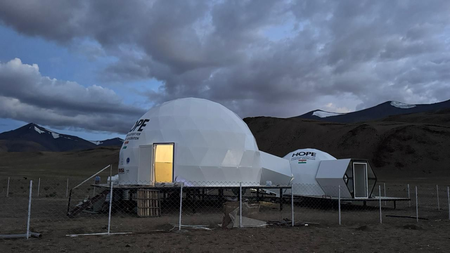
New Delhi: In a significant step toward India's future in human space exploration, the Indian Space Research Organisation (ISRO) has launched the country's first analogue space mission, named HOPE (Human Outer Planet Exploration), in Ladakh.
Inaugurated by ISRO Chairman Dr. V. Narayanan, the HOPE analogue station has placed aerospace engineer Rahul Mogalapalli and astrobiologist Yaman Akot in isolated conditions to simulate life on another planet.
"This analogue mission is more than just a simulation—it's a rehearsal for the future," said Dr. Narayanan at the launch.
The two crew members will spend 10 days (August 1–10, 2025) at the analogue site in Tso Kar, a high-altitude location in Ladakh at 4,530 metres elevation. The mission is designed to test their physical and psychological endurance under Mars-like conditions.
ISRO selected Tso Kar Valley due to its environmental similarities with early Mars—including high UV radiation, low atmospheric pressure, extreme cold, and saline permafrost. These features make it an ideal Earth-based site to simulate extraterrestrial missions.
The HOPE station was developed jointly by ISRO and Protoplanet, a Bengaluru-based space tech company. It consists of:
A diameter 8-metre crew habitat module for living
A diameter 5-metre utility module for operations and support systems
Both modules are interconnected to allow smooth crew workflow during the mission.
The mission includes scientific experiments proposed by top Indian research institutions such as:
Indian Institute of Space Science and Technology (IIST)
Rajiv Gandhi Centre for Biotechnology (RGCB), Thiruvananthapuram
IIT Hyderabad
IIT Bombay
Institute of Aerospace Medicine, Bengaluru
These experiments will study the epigenetic, genomic, physiological, and psychological responses of the crew to planetary conditions. It will also validate:
Health monitoring protocols
Planetary surface operations
Sample collection techniques
Microbial analysis procedures
This mission is part of India’s roadmap to send astronauts to Low Earth Orbit by 2027 and a manned Moon mission by 2040. The insights gained from HOPE will inform critical aspects of human spaceflight—technology performance, crew behavior, and environmental adaptation.
ISRO concluded:
"The data gathered will lay the groundwork for future Indian human space missions by shaping mission protocols and habitat infrastructure."
With inputs from IANS